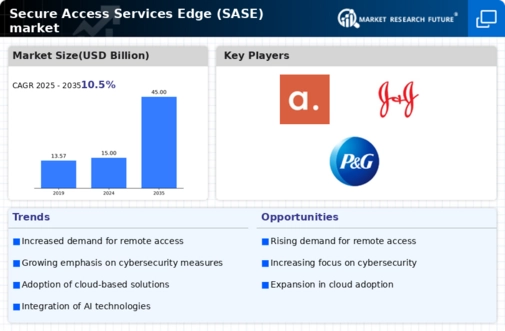The secure access services edge market is currently characterized by a dynamic competitive landscape, driven by the increasing demand for secure and efficient network access solutions. Key players such as Zscaler (US), Cisco (US), and Palo Alto Networks (US) are at the forefront, each adopting distinct strategies to enhance their market positioning. Zscaler (US) focuses on innovation through its cloud-native platform, which emphasizes zero trust security, while Cisco (US) leverages its extensive networking expertise to integrate secure access solutions into its broader portfolio. Palo Alto Networks (US) is enhancing its offerings through strategic acquisitions, aiming to provide comprehensive security solutions that encompass both network and endpoint security. Collectively, these strategies contribute to a competitive environment that is increasingly centered around technological advancement and customer-centric solutions.
In terms of business tactics, companies are increasingly localizing their operations and optimizing supply chains to enhance responsiveness to market demands. The market structure appears moderately fragmented, with several players vying for market share, yet dominated by a few key firms that exert considerable influence. This competitive structure fosters innovation, as companies strive to differentiate their offerings in a crowded marketplace.
In November 2025, Zscaler (US) announced a partnership with a leading telecommunications provider to enhance its secure access services, indicating a strategic move towards expanding its reach and capabilities in the market. This collaboration is likely to bolster Zscaler's service delivery and customer engagement, positioning it favorably against competitors. Similarly, in October 2025, Cisco (US) unveiled a new suite of security features integrated into its existing networking solutions, reflecting its commitment to providing comprehensive security across all access points. This development not only strengthens Cisco's competitive edge but also aligns with the growing trend of integrated security solutions.
In September 2025, Palo Alto Networks (US) completed the acquisition of a cybersecurity startup specializing in AI-driven threat detection. This acquisition is poised to enhance Palo Alto's capabilities in proactive security measures, potentially setting a new standard in the industry. The integration of AI into their offerings may provide a significant competitive advantage, as organizations increasingly seek advanced solutions to combat evolving cyber threats.
As of December 2025, the competitive trends in the secure access services edge market are heavily influenced by digitalization, sustainability, and the integration of AI technologies. Strategic alliances are becoming increasingly pivotal, as companies recognize the value of collaboration in enhancing their service offerings and market reach. Looking ahead, competitive differentiation is likely to evolve, with a pronounced shift from price-based competition to a focus on innovation, technological advancement, and supply chain reliability. This transition underscores the necessity for companies to not only deliver cost-effective solutions but also to invest in cutting-edge technologies that meet the evolving needs of their customers.














Leave a Comment